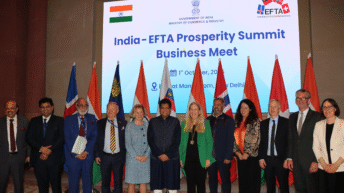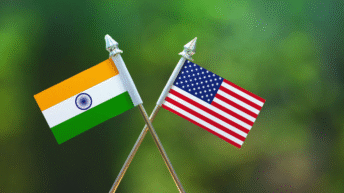
India must tackle the psychological war waged by PRC and its sympathisers within the country.
Keywords: Psychological warfare | Expansionism | South Asia | Military Might | CPI | Left-Propaganda | Contemporary Indian History
Part of the strategy behind the expansionism of the People’s Republic of China (PRC) in South and South-East Asia is psychological warfare or psy-war which is a fabricated projection of one’s military might. This propaganda is aimed at serving the PLA a psychological edge in any probable war or to deter any possible adversaries. It also provides the necessary leverage to the Communist leadership in any diplomatic negotiations within the global or regional arena. The principle of aggrandisement is associated with the very establishment of the Communist state. Mao Zedong’s consideration of Ladakh, Nepal, Bhutan, Sikkim and Arunachal Pradesh as the five fingers of China’s right palm Tibet, reflects the colonising psyche. In the post-Mao era, the Communist Party shifted to Market Socialism but remained committed to Mao’s call for aggrandisement, albeit in a subdued form. Pakistan, irrespective of any party or military in power, has almost become a Chinese colony. Beijing’s strategy to colonise Sri Lanka and Bangladesh is through soft-loans. The anti-India rhetoric of Kathmandu is a shadow war of China and a consequence of the Communist party’s rise to power in the buffer state. Building up a formidable image of itself is the key strategy of Chinese expansionism in its neighbourhood. China’s India policy is also backed by its policy of psy-war. India must tackle this as a precondition to fight the dragon in any probable war.
Mao Zedong’s consideration of Ladakh, Nepal, Bhutan, Sikkim and Arunachal Pradesh as the five fingers of China’s right palm Tibet, reflects the colonising psyche.
Beijing follows three major policies in the psywar. The first is to project it’s offensive policy as a defence against the opponent’s ‘forward policy’, i.e. playing a victim card. To justify the Chinese attack in 1962, the Communist state propagated the war as a consequence of India’s ‘forward policy’. The same argument is echoed in scholar Neville Maxwell’s book ‘India’s China War’. However, strategist Bertil Lintner, in his work ‘China’s India War’, published in 2016, refuted Maxwell’s theory of ‘forward’ policy. During the 2016 Doklam Standoff and recent dispute in the Galwan Valley, China again played the same victim card. As a second strategy, Beijing cherry picks laws and ethics in justifying its territorial claims backed by maps and agreements which are in its sole possession.
While PRC has a total of 2.7 million troops to protect its 22000 km long land-border, India’s total military strength is 3.5 million for about 15000 km.
However, the most important is the third strategy that seeks to establish the superiority of the PLA in the immediate neighbourhood. While PRC has a total of 2.7 million troops to protect its 22000 km long land-border, India’s total military strength is 3.5 million for about 15000 km. Importantly, among fourteen neighbours of China, it shares troubled relations with almost every country excluding Russia, Pakistan, North Korea and Nepal. Therefore, in any probable war with India, it will be suicidal for Beijing to deploy more than fifty per cent of its troops on the India-China border. PRC is ahead of India in terms of numerical supremacy of technology and Weapons of Mass Destruction, but in qualitative terms this much-hyped supremacy is questionable. The materialisation of defence deals like Rafale will tilt the power structure in India’s favour.
The critics-cum-activists who oppose any developmental projects in the name of displacement, environmentalism, human rights in India, maintain an eerie silence on Beijing’s Hong Kong policy, treatment of Uyghur Muslims, and media control.
The consent building in India is backed by a largely leftist and pro-Chinese ecosystem. The Goebbels-style propaganda mechanism of Indian left survives till date and reveals itself from time to time. Thus, the political weakening of the Indian left does not mean that China’s psychological warfare strategy has been thwarted. At the centres of higher education in India, China is glorified as a role model of development and even the ideals of the Cultural Revolution are celebrated. The critics-cum-activists who oppose any developmental projects in the name of displacement, environmentalism, human rights in India, maintain an eerie silence on Beijing’s Hong Kong policy, treatment of Uyghur Muslims, and media control. In the curricula of Contemporary Indian History or India’s Foreign Policy in Indian universities, the 1962 war between India and China is highlighted to make a long term impression in the collective memory. However, the battles of Nathu-La and Cho-La in 1967, in which the Indian Army crushed Mao’s troops are starkly absent in the syllabi and also in the Indian psyche. Indian universities do not focus on the fairly long list of China’s many defeats. The PLA had a humiliating defeat in the hands of Vietnam in 1979, when Beijing attempted a ‘forward policy’ to submit Hanoi. Left dominated Indian universities teach that ‘Tibet’ had always been, politically, a part of China. Unfortunately, no Indian university mentions that, for a long time, Jammu and Kashmir included large areas of Tibet.
The battles of Nathu-La and Cho-La in 1967, in which the Indian Army crushed Mao’s troops are starkly absent in the syllabi and also in the Indian psyche.
It is the leftists who glorify China’s model as the ideal for development but oppose the hydropower projects in the North-East to the Nuclear power plant in the South, on both political and legal fronts. They decry the budgetary increment in the defence sector by making binary comparisons with social sector development. We must realise that it is not easy for the Indian defence sector with an annual expenditure of 65 billion USD, to take on aggrandising PLA with a yearly expenditure of 178 billion USD.
We must not forget how the left politics in India had a theoretical debate on the question of loyalty to either USSR or the PRC, but the question of loyalty to India was never relevant.
By agitating against basic issues like industries, power plants, the leftists keep India poor and by opposing spending on defence, they secure leverage in favour of China. We must not forget how the left politics in India had a theoretical debate on the question of loyalty to either USSR or the PRC, but the question of loyalty to India was never relevant. The CPI (M) celebrated Chinese intrusion in the North East in 1962 and still continues to pay habitual loyalty through its Bengali mouthpiece ‘Ganashakti’ to the PLA, even after the Galwan clash.
The nexus among some sections of intellectuals, media, NGOs works as an arm of the propaganda office of China, aiming to psychologically wreck India from within. In their relentless dissemination of a hyped Chinese superiority in the field of economy and defence, India is no match. Their role much resembles the character of Shalya, who became Karna’s charioteer in the Kurukshetra war in Mahabharata. This psychological war must be won as a precondition for winning the war on the borders.






Exellant article.
“Consent building in India for China by Leftist and pro China Eco system “ is a fallacy . 1962 debacle is so well ingrained in every Indian, that Chinese are as good as warring Aliens . Since 1964 , its help to Pakistan and supporting it in International forums too makes China abhorrent to the Common Indian.
But China has made a deep in roads into the Economic eco system . Large factories including car making, surveillance equipment making inaugurated by NSA last October, steel making, investment s in IPL, ISL, SEZs , Start Ups ,,hospitality sector, media and the list is too long. Is this the Eco system being referred to ? If so it’s been kept vague for reasons best known to the author. This is the “keel “ of the their Psy W & our administration and political leaders are a party to it , due to compulsions of election funding by Indian business houses which are partners or benefit the most from our relationship with China.
Wish the author had belled the Cat.
But yes , with social media very active with good stories of the Chinese when they are belligerent and aggressors, there is need for the social media users to be vigilant. It can ne done by a social media watch dog which issue denials to such rampant social media and even mainstream print and electronic media stories preaching good aspects and happenings of Indo- China relationship or false praise of India( in this instance, extolling our success In fight against COVID 19) .
The Indian Parliament must debate Chinese Mis information and mainstream and vernacular media must publish / discuss these Parliamentary debates.
Chinese help to Pakistan, its Skullduggery in 1962 and now in NE Ladakh must be taught in School alongwith the Inimical attitude of Pakistan, to program each young Indian to identify correctly , the main external Enemies of this wonderful nation. This will arm them to deal with in a rational manner and not go overboard on Chinese offers of developing factories, Start Ups etc etc .
Honour and Security of the Nation is “first and foremost “ .